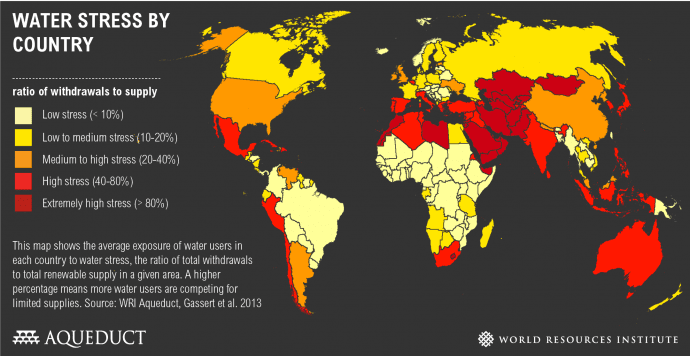37 lande er så følsomme overfor vandforsyningen, at selv den mindste ændring kan få katastrofale følger. Det gælder bl. a. en del af de olierige stater i Mellemøsten, konkluderer ny undersøgelse af World Ressources Institute.
Providing stable freshwater supplies is a priority for every country in the world, writes World Resources Institute Tuesday.
Yet stable supplies are increasingly hard to come by in many countries, as water-related risks increase. For example, recent droughts threatened GDP growth in the United States.
Monsoon floods killed hundreds and displaced thousands in India. Increased competition for water may impact energy production in China, and the list goes on.
WRI’s Aqueduct project recently evaluated, mapped, and scored water risks like these in 100 river basins, ranked by area and population, and 181 nations—the first such country-level water assessment of its kind.
We found that 37 countries face “extremely high” levels of baseline water stress (see list at bottom). This means that more than 80 percent of the water available to agricultural, domestic, and industrial users is withdrawn annually—leaving businesses, farms, and communities vulnerable to scarcity.
Evaluating national water risks
We started with local-level data from the Aqueduct Water Risk Atlas. Using statistical methods to account for where water is being used within a particular country, we brought this local-level data to the country scale, looking at baseline water stress, as well as floods, droughts, inter-annual variability, and seasonal variability.
Countries received a score of 0-5 for each indicator—the higher the score, the greater the exposure to that particular water risk.
Baseline water stress measures how much water is withdrawn every year from rivers, streams, and shallow aquifers for domestic, agricultural, and industrial uses.
Scores above 4 indicate that, for the average water user, more than 80 percent of the water available is withdrawn annually. That means companies, farms, and residents are highly dependent on limited amounts of water and vulnerable to even the slightest change in supply.
Such situations severely threaten national water security and economic growth–especially if a country does not have adequate water-management plans in place.
National and local governments must respond with management and conservation practices that will ensure long-term availability of water resources for all users, including the environment.
Why Is It Important to Analyze Water Risk at the Country Level?
Our analysis reveals that 37 percent of countries we assessed experience high to extremely high baseline water stress. This information is highly relevant for a country’s economy, environment, and communities. Yet until now, scant country-level water risk data existed.
Water data is usually collected and reported at local geographic scales. However, water-related decisions and investments are often made at much larger scales, requiring country-level information.
Commercial banks, for example, usually evaluate certain types of risk (e.g. political, social, and economic risk) to their global portfolios at the country level. Without accurate measures of countries’ water risk, such banks might ignore water-related risks to their investments. There is, therefore, a compelling need to translate locally collected or locally modeled water risk data to the country level.
Læs mere og se listen her: http://www.wri.org/blog/world%E2%80%99s-37-most-water-stressed-countries














